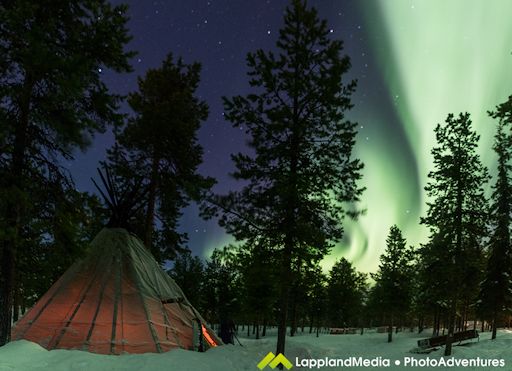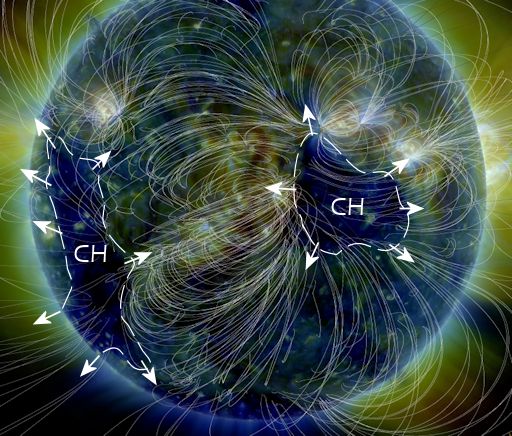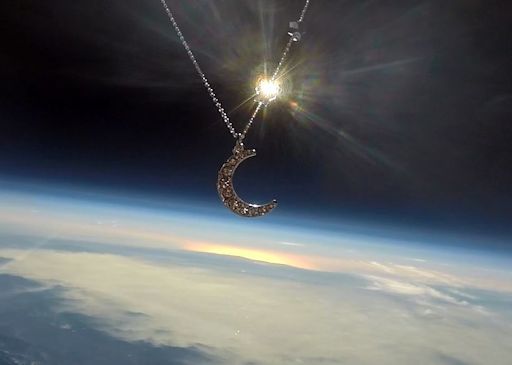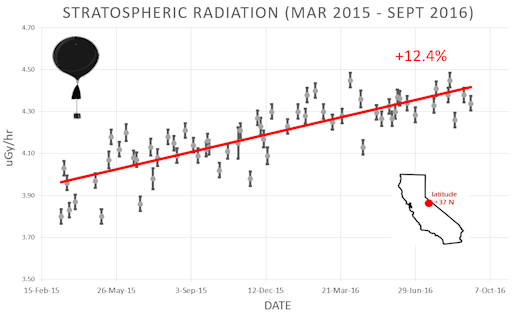Marianne's Arctic Xpress supports World Cancer Day by donating 50% of the price paid on all bookings Feb. 3-5 to cancer research. Arctic clothing and semi-pro cameras included. Groups of 2 to 8 welcome. Book Now | | | WEEKEND AURORA WATCH: NOAA forecasters estimate a 40% chance of polar geomagnetic storms on Jan. 28th when a stream of fast-moving solar wind is expected to hit Earth's magnetic field. Arctic sky watchers should be alert for auroras this weekend. Free: Aurora Alerts "You know that you have seen something special when the snow turns green," says aurora tour guide Peter Rosen, who took this picture on Jan. 18th from the Reindeer Lodge in Kiruna, Sweden: 
"We had some amazing aurora last week and the forecast looks good for this weekend as well," he says. Realtime Aurora Photo Gallery TWO BIG HOLES IN THE SUN'S ATMOSPHERE: NASA's Solar Dynamics Observatory is now tracking two large holes in the sun's atmosphere. One (on the right) is almost directly facing Earth, and the other (left) is still turning toward us: 
These are "coronal holes" (CHs)--places in the sun's atmosphere where the sun's magnetic field opens up and allows solar wind to escape. Coronal holes turn the sun into a kind of gassy lighthouse. They strobe Earth with streams of solar wind every 27 days, the rotation period of the sun. Earth will encounter solar wind streams from both of these holes. The first is due to arrive on Jan. 28th. The second, larger stream should reach our planet on or about Feb 1st. Arctic sky watchers, mark you calendars; auroras are in the offing. Realtime Space Weather Photo Gallery FAR-OUT VALENTINE'S GIFT: To raise money for their cosmic ray ballooning program, the students of Earth to Sky Calculus have flown a payload-full of Valentine's pendants to the edge of space--and you can have one for $89.95. Buy one this week and we will include a space rose free of charge. 
Each glittering pendant comes with a greeting card showing the jewelry in flight and certifying that it has been to the stratosphere and back again. More far-out Valentine's gifts may be found in the Earth to Sky store. All proceeds support cosmic ray balloon flights and STEM education.
Realtime Airglow Photo Gallery
Realtime Sprite Photo Gallery Every night, a network of NASA all-sky cameras scans the skies above the United States for meteoritic fireballs. Automated software maintained by NASA's Meteoroid Environment Office calculates their orbits, velocity, penetration depth in Earth's atmosphere and many other characteristics. Daily results are presented here on Spaceweather.com. On Jan. 26, 2017, the network reported 13 fireballs.
(13 sporadics)  In this diagram of the inner solar system, all of the fireball orbits intersect at a single point--Earth. The orbits are color-coded by velocity, from slow (red) to fast (blue). [Larger image] [movies] Potentially Hazardous Asteroids ( PHAs) are space rocks larger than approximately 100m that can come closer to Earth than 0.05 AU. None of the known PHAs is on a collision course with our planet, although astronomers are finding new ones all the time. On January 26, 2017 there were potentially hazardous asteroids. Notes: LD means "Lunar Distance." 1 LD = 384,401 km, the distance between Earth and the Moon. 1 LD also equals 0.00256 AU. MAG is the visual magnitude of the asteroid on the date of closest approach. | | Cosmic Rays in the Atmosphere |
Readers, thank you for your patience while we continue to develop this new section of Spaceweather.com. We've been working to streamline our data reduction, allowing us to post results from balloon flights much more rapidly, and we have developed a new data product, shown here: 
This plot displays radiation measurements not only in the stratosphere, but also at aviation altitudes. Dose rates are expessed as multiples of sea level. For instance, we see that boarding a plane that flies at 25,000 feet exposes passengers to dose rates ~10x higher than sea level. At 40,000 feet, the multiplier is closer to 50x. These measurements are made by our usual cosmic ray payload as it passes through aviation altitudes en route to the stratosphere over California. What is this all about? Approximately once a week, Spaceweather.com and the students of Earth to Sky Calculus fly space weather balloons to the stratosphere over California. These balloons are equipped with radiation sensors that detect cosmic rays, a surprisingly "down to Earth" form of space weather. Cosmic rays can seed clouds, trigger lightning, and penetrate commercial airplanes. Furthermore, there are studies ( #1, #2, #3, #4) linking cosmic rays with cardiac arrhythmias and sudden cardiac death in the general population. Our latest measurements show that cosmic rays are intensifying, with an increase of more than 12% since 2015: 
Why are cosmic rays intensifying? The main reason is the sun. Solar storm clouds such as coronal mass ejections (CMEs) sweep aside cosmic rays when they pass by Earth. During Solar Maximum, CMEs are abundant and cosmic rays are held at bay. Now, however, the solar cycle is swinging toward Solar Minimum, allowing cosmic rays to return. Another reason could be the weakening of Earth's magnetic field, which helps protect us from deep-space radiation. The radiation sensors onboard our helium balloons detect X-rays and gamma-rays in the energy range 10 keV to 20 MeV. These energies span the range of medical X-ray machines and airport security scanners. The data points in the graph above correspond to the peak of the Reneger-Pfotzer maximum, which lies about 67,000 feet above central California. When cosmic rays crash into Earth's atmosphere, they produce a spray of secondary particles that is most intense at the entrance to the stratosphere. Physicists Eric Reneger and Georg Pfotzer discovered the maximum using balloons in the 1930s and it is what we are measuring today. | | The official U.S. government space weather bureau | | | The first place to look for information about sundogs, pillars, rainbows and related phenomena. | | | Researchers call it a "Hubble for the sun." SDO is the most advanced solar observatory ever. | | | 3D views of the sun from NASA's Solar and Terrestrial Relations Observatory | | | Realtime and archival images of the Sun from SOHO. | | | from the NOAA Space Environment Center | | | a proud supporter of science education and Spaceweather.com | | | the underlying science of space weather |  | Beautyz for top beauty products reviews and their buying guides | | | These links help Spaceweather.com stay online. Thank you to our supporters! | | 
